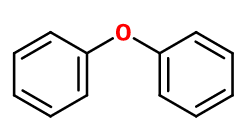
Photo credits: ScenTree SAS
Do you sell any of the raw materials? Would you like to let our users know?
Send an email to fournisseurs@scentree.coto learn about our advertising opportunities.
Do you sell any of the raw materials? Would you like to let our users know?
Send an email to fournisseurs@scentree.coto learn about our advertising opportunities.
General Presentation
-
CAS N° : 101-84-8
-
EINECS number : 202-981-2
-
FEMA number : 3667
-
FLAVIS number : 04.035
-
JECFA number : 1255
-
Appearance : Colorless liquid that crystallizes at room temperature
-
Density : 1,073
-
Volatility : Heart
-
Price Range : €
Physico-chemical properties
-
Molecular formula : C12H10O
-
Molecular Weight : 170,21 g/mol
-
Log P : 4,21
-
Fusion Point : Donnée indisponible.
-
Boiling Point : 259°C
-
Detection Threshold : Donnée indisponible.
-
Optical rotation : Donnée indisponible
-
Vapor pressure : Donnée indisponible
-
Refractive Index @20°C : Donnée indisponible
-
Acid Value : Donnée indisponible.
-
Flash Point : 115°C
Uses
Uses in perfumery :
Diphenyl Oxide is used in all types of perfumes, for reconstitutions of rose, geranium and lavender. Gets on well with citruses to boost the head and make the note last longer. Gives a metallic and cold effect. Widely used in functional perfumery.
Year of discovery :
Data not available.
Natural availability :
Diphenyl Oxide is not available in its natural state.
Isomerism :
Oranger Crystals® is a constitutional isomer of Diphenyl Oxide although it does not have the same smell, as it is closer to orange blossom.
Synthesis precursor :
Diphenyl Oxide is not a precursor to the synthesis of another compound of olfactory interest.
Synthesis route :
Diphenyl Oxide is synthesized as an intermediate in the synthesis of phenol. This synthesis is done by hydrolysis of chlorobenzene under a very high pressure.
Regulations & IFRA
Allergens :
This ingredient does not contain any allergen.
IFRA 51th :
This ingredient is not restricted for the 51th amendment

